Publications
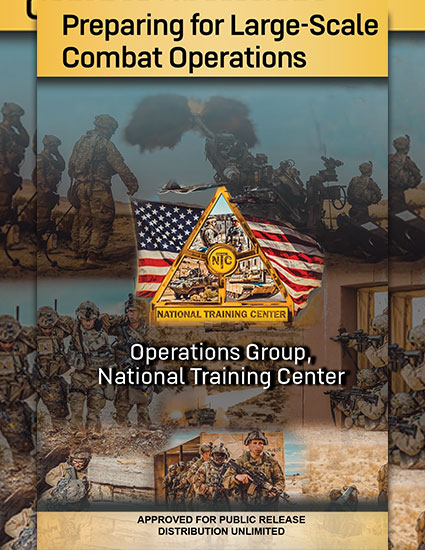 21-06 - Preparing for Large-Scale Combat Operations
21-06 - Preparing for Large-Scale Combat Operations
The purpose of this handbook is to set forth the “how to fight” concept and commensurate training techniques at echelon that allow units to succeed at the National Training Center (NTC). Leaders at NTC specifically designed this handbook to help units at echelon understand an operational environment, develop tactics, techniques, and procedures for success, and better understand how to train for this environment at home station. By combining the lessons in this handbook with the Army’s current training strategies, units training at home station will arrive at the NTC better prepared to conduct large-scale combat operations against a near-peer threat.
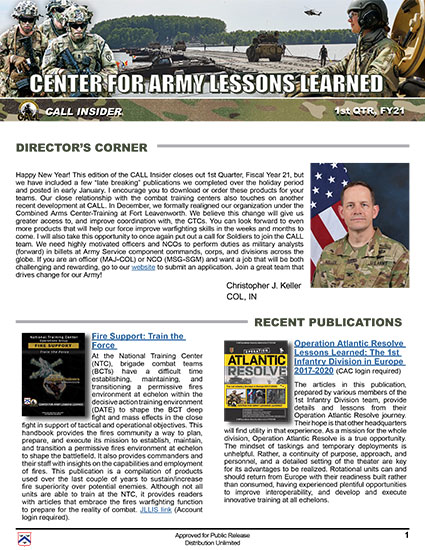 CALL Insider Newsletter, 1st QTR, FY21
CALL Insider Newsletter, 1st QTR, FY21
This edition of the CALL Insider features our roll-up of 1st quarter publications, reports, and articles. We continue to seek hard charging senior NCOs (MSG-SGM) and officers (MAJ-COL) to fill our military analyst (forward) positions at the Army Service component commands, corps, and divisions -- if you think you have what it takes, click on the provided link and submit an application! Finally, don’t miss the latest news and trends from the combat training centers!
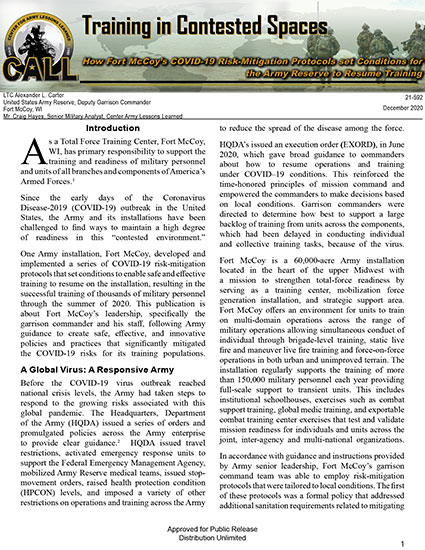 News From the Front: Training in Contested Spaces
News From the Front: Training in Contested Spaces
Fort McCoy developed and implemented a series of COVID-19 risk-mitigation protocols that set conditions to enable safe and effective training to resume on the installation, resulting in the successful training of thousands of military personnel through the summer of 2020. This publication is about Fort McCoy's leadership, specifically the garrison commander and his staff, following Army guidance to create safe, effective, and innovative policies and practices that significantly mitigated the COVID-19 risks for its training populations.
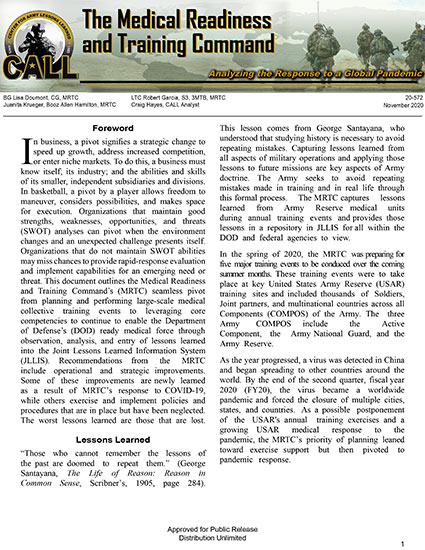 News From the Front: The Medical Readiness and Training Command: Analyzing the Response to a Global Pandemic
News From the Front: The Medical Readiness and Training Command: Analyzing the Response to a Global Pandemic
Organizations that maintain good strengths, weaknesses, opportunities, and threats analyses can pivot when the environment changes and an unexpected challenge presents itself. This document outlines the Medical Readiness and Training Command’s (MRTC) seamless pivot from planning and performing large-scale medical collective training events to leveraging core competencies to continue to enable the Department of Defense’s ready medical force through observation, analysis, and entry of lessons learned into the Joint Lessons Learned Information System. Recommendations from the MRTC include operational and strategic improvements. Some of these improvements are newly learned as a result of MRTC’s response to COVID-19, while others exercise and implement policies and procedures that are in place but have been neglected.
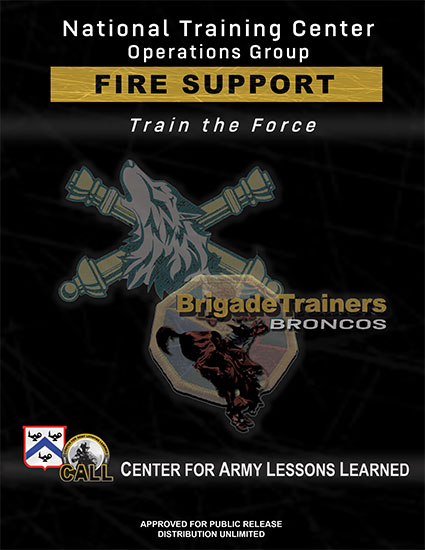 21-05 - NTC Fire Support Handbook
21-05 - NTC Fire Support Handbook
At the National Training Center, brigade combat teams (BCTs) have a difficult time establishing, maintaining, and transitioning a permissive fires environment at echelon within the decisive action training environment to shape the BCT deep fight and mass effects in the close fight in support of tactical and operational objectives. This handbook provides the fires community a way to plan, prepare, and execute its mission to establish, maintain, and transition a permissive fires environment at echelon to shape the battlefield. It also provides commanders and their staff with insights on the capabilities and employment of fires.
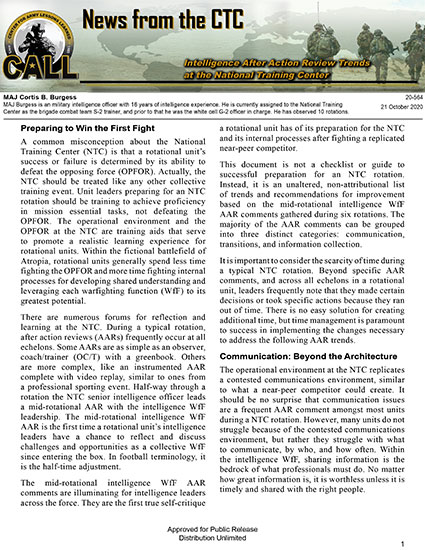 NFTCTC - Intelligence After Action Review Trends at the National Training Center
NFTCTC - Intelligence After Action Review Trends at the National Training Center
This article delivers an unaltered, non-attributional list of trends and recommendations for improvement based on the mid-rotational intelligence warfighting function after action review (AAR) comments gathered during six rotations. The majority of the AAR comments can be grouped into three distinct categories: communication, transitions, and information collection.
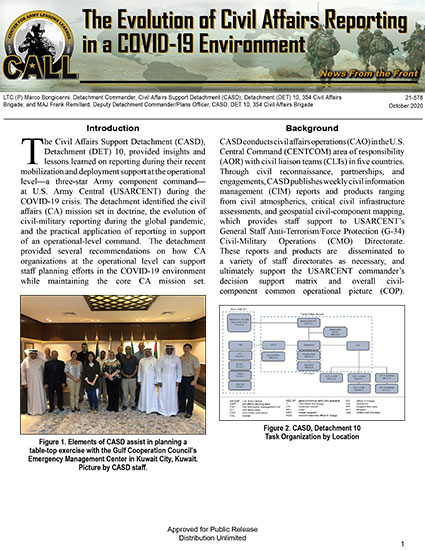 21-578 - News From the Front: The Evolution of Civil Affairs Reporting in a COVID-19 Environment
21-578 - News From the Front: The Evolution of Civil Affairs Reporting in a COVID-19 Environment
Members of Civil Affairs Support Detachment 10 provided insights and lessons learned on reporting during their recent mobilization and deployment support as part of U.S. Army Central during the COVID-19 crisis. The detachment identified the civil affairs mission set in doctrine, the evolution of civil-military reporting during the global pandemic, and the practical application of reporting in support of an operational-level command. The detachment provided several recommendations on how organizations at the operational level can support staff planning efforts in the COVID-19 environment while maintaining core mission set.
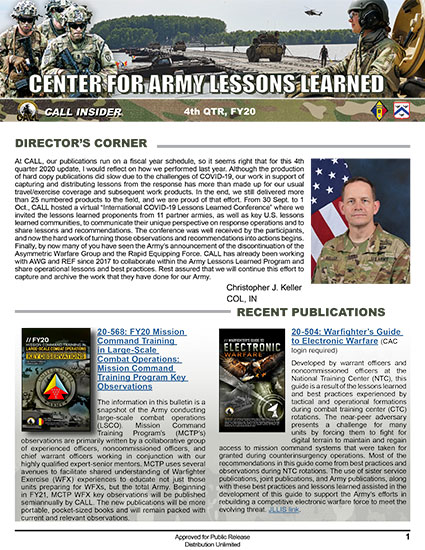 CALL Insider, 4th Qtr, FY20 Newsletter
CALL Insider, 4th Qtr, FY20 Newsletter
This edition of the CALL Insider features our roll-up of 4th quarter FY 20 publications, articles, studies, reports, and upcoming publications. Check out the flyer on page 5 for “Army 21: Brigade Combat Teams” – an interactive, multimedia learning tool designed to help Soldiers visualize and explore formations and organizations. Finally, don’t miss the latest news from the combat training centers!
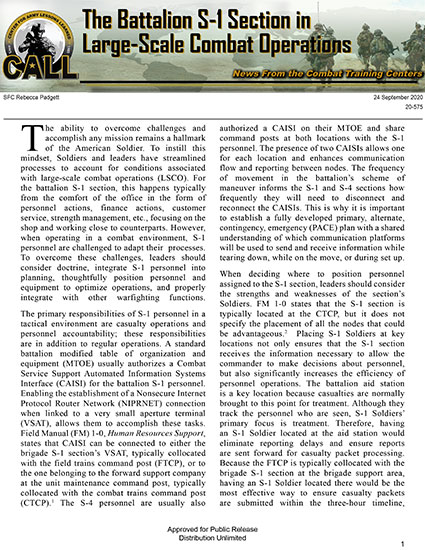 20-575 - The Battalion S-1 Section in Large-Scale Combat Operations
20-575 - The Battalion S-1 Section in Large-Scale Combat Operations
The ability to overcome challenges and accomplish any mission remains a hallmark of the American Soldier. To instill this mindset, Soldiers and leaders have streamlined processes to account for conditions associated with large-scale combat operations. For the battalion S-1 section, this happens typically from the comfort of the office in the form of personnel actions, finance actions, customer service, strength management, etc., focusing on the shop and working close to counterparts. However, when operating in a combat environment, S-1 personnel are challenged to adapt their processes. To overcome these challenges, leaders should consider doctrine, integrate S-1 personnel into planning, thoughtfully position personnel and equipment to optimize operations, and properly integrate with other warfighting functions.
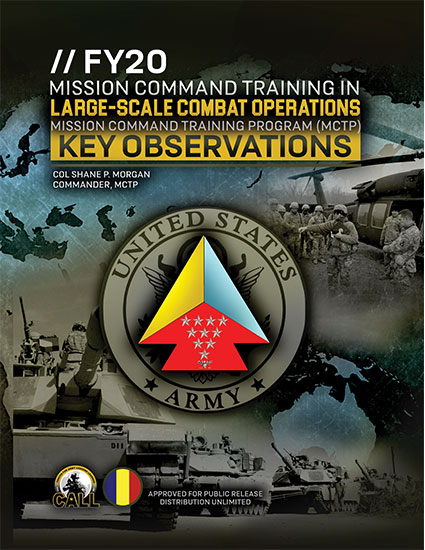 20-568 - FY20 Mission Command Training in Large-Scale Combat Operations - Mission Command Training Program (MCTP) Key Observations
20-568 - FY20 Mission Command Training in Large-Scale Combat Operations - Mission Command Training Program (MCTP) Key Observations
The information in this bulletin is a snapshot of the Army conducting large-scale combat operations. MCTP’s observations are primarily written by a collaborative group of experienced officers, noncommissioned officers, and chief warrant officers working in conjunction with highly qualified expert-senior mentors. MCTP uses several avenues to facilitate shared understanding of Warfighter Exercise (WFX) experiences to educate not just those units preparing for WFXs, but the total Army. Beginning in FY21, the MCTP WFX key observations will be published semiannually by CALL. The new publications will be more portable, pocket-sized books and will remain packed with current and relevant observations.
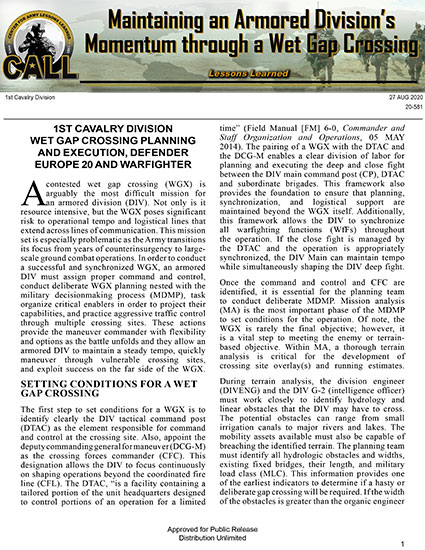 Maintaining an Armored Division’s Momentum through a Wet Gap Crossing
Maintaining an Armored Division’s Momentum through a Wet Gap Crossing
A contested wet gap crossing (WGX) is arguably the most difficult mission for an armored division. Not only is it resource intensive, but the WGX poses significant risk to operational tempo and logistical lines that extend across lines of communication. In order to conduct a successful and synchronized WGX, an armored division must assign proper command and control, conduct deliberate WGX planning nested with the military decision-making process (MDMP), task
organize critical enablers in order to project their capabilities, and practice aggressive traffic control through multiple crossing sites. These actions provide the maneuver commander with flexibility and options as the battle unfolds and they allow an
armored division to maintain a steady tempo, quickly maneuver through vulnerable crossing sites, and exploit success on the far side of the WGX. This article outlines some of the 1st Cavalry Division's lessons from planning and execution during Defender Europe 20 and a Warfighter exercise.
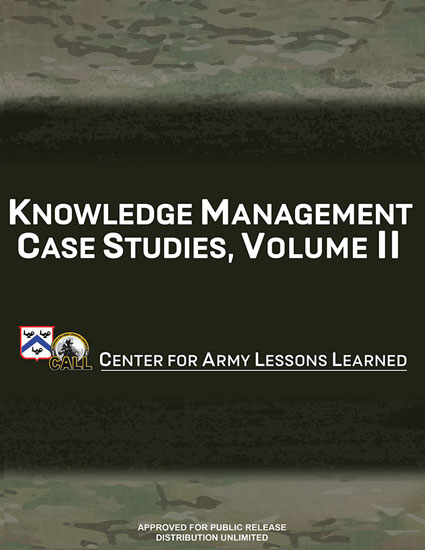 Knowledge Management Case Studies, Volume II
Knowledge Management Case Studies, Volume II
These Knowledge Management (KM) case studies highlight where an empowered KM officer applied KM principles to solve a problem. The KM officers in each case study achieved success by exercising initiative, applying critical and creative thinking, and ultimately delivering a capability or process that made their teams more effective and efficient. The Army’s data, information, and knowledge environment will continue to become more complex. These case studies provide illustrative examples of KM practices in action, and stimulate thinking among leaders and staffs looking to harness the power of KM in their headquarters.

